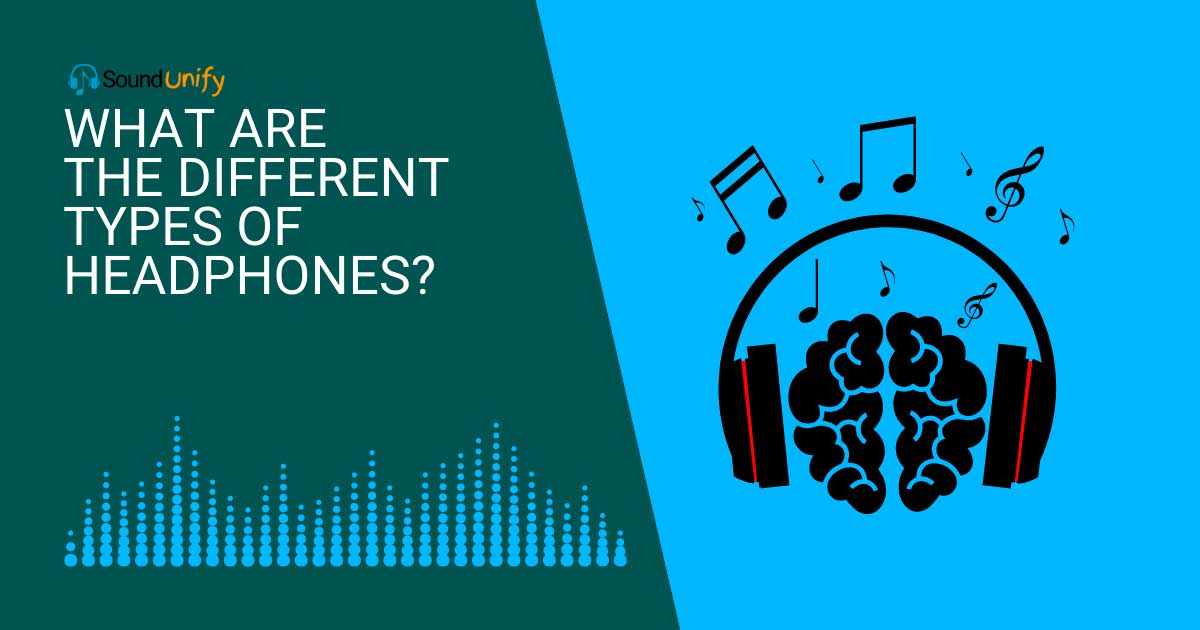A headphone is a pair of small loudspeaker drivers that users wear around their heads over their ears. They are one of the most popular audio devices in the world nowadays. Those small devices can transform an electric signal into a corresponding sound.
Whether in the gym, on a road trip, or just wanting to enjoy music in peace and quiet, headphones are the perfect solution.
And, as technology evolves, so do the types of headphones on the market. It allows you to listen to your music peacefully and without noise interference. Those are also indispensable for many other activities like gaming or computer work.
You’ll learn about different kinds of headphones in size, design, connectivity, and technology. So, no matter your needs, you’ll be able to find the perfect pair of headphones on this list.
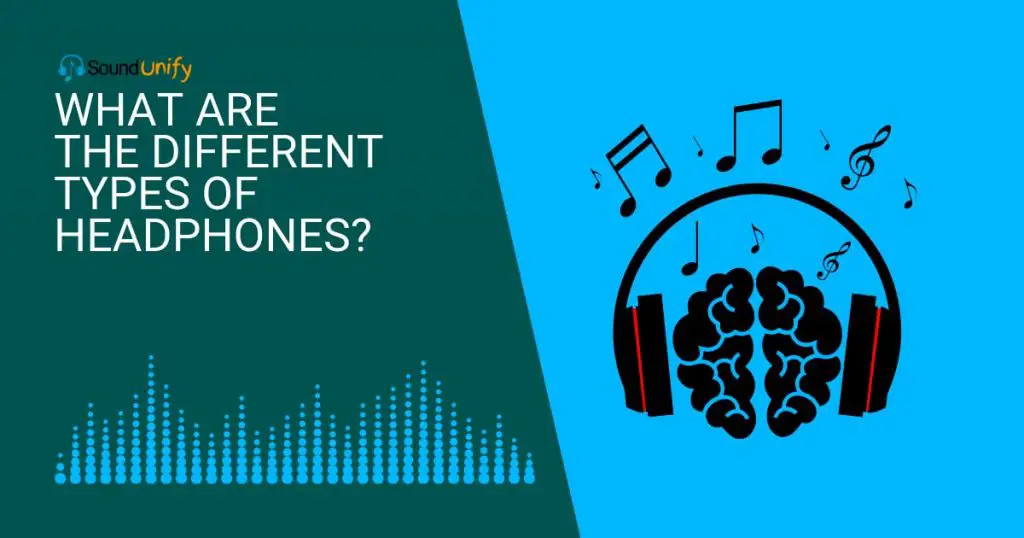
What Are Headphones?
Headphones are a kind of audio device that helps you listen to music or watch videos without disturbing others.
Using a cord or wireless technology like DECT, Bluetooth, or FM radio, headphones can connect to a signal source such as a mobile phone, CD player, audio amplifier, portable media player, video game console, radio, or electronic musical instrument.
Headphones come in different sizes and shapes, with various features and capabilities, like noise-canceling capabilities. There are headphones designed for personal use, like on-ear headphones. Earbuds are meant for exercise or working out.
So, what type of headphones are best for you? It depends on your needs and preferences.
Types of Headphones by Size
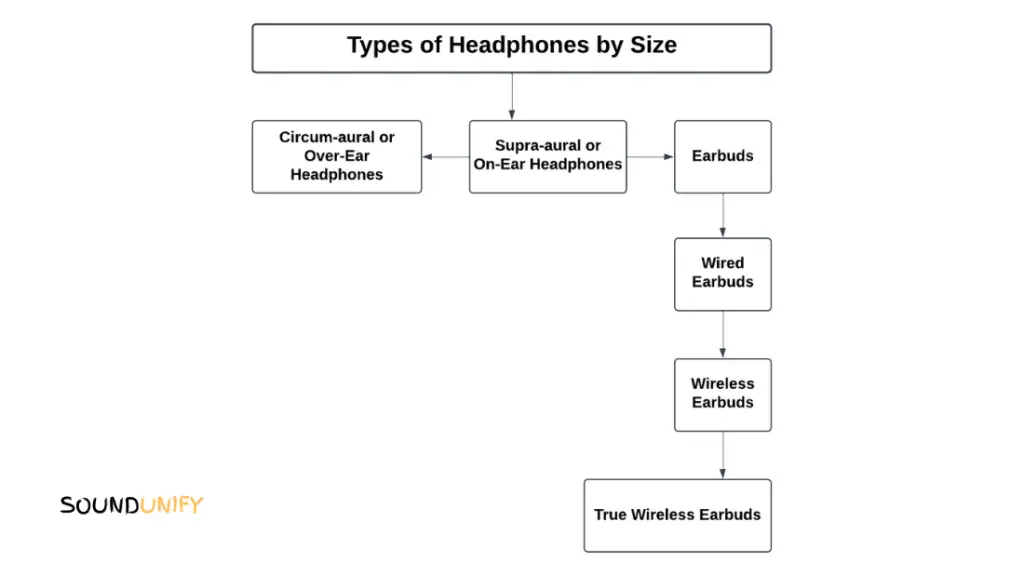
There are different types of headphones by size and quality. Each of them differs from another.
1. Circum-aural or Over-Ear Headphones
Over-ear headphones typically have larger circular or ellipsoid earpads that cover the ears than on-ear headphones. They can provide better sound quality than on-ear headphones and block out more noise from your surroundings.
Many prefer these headphones because they offer a better overall bass response and sound quality. However, over-ear headphones are bulkier and may not be as comfortable when playing games or working on a computer. So, an ergonomic headband and earpad design are important to eliminate discomfort.
Advantages
- Don’t put any pressure on your ears. So, that feels more comfortable.
- It provides better sound quality by sealing off your ear from outside noise.
- Don’t pump the music directly into your ear. So, the hearing damage possibility is low.
2. Supra-aural or On-Ear Headphones
On-ear headphones cover the top of your ears or press against your ear, unlike over-ear headphones, which go around your ears. They are typically lighter and more compact than over-ear headphones, making them a good choice for people who want a portable option. They also tend to be less expensive than over-ear headphones.
Advantages
- Don’t completely enclose your ears, so they’re less likely to cause ear fatigue.
- Typically have better sound quality than earbuds.
- More compact, portable, and less expensive than over-ear headphones.
3. Earbuds
Earbuds are small, cylindrical-shaped speakers that fit inside the ear canal. Unlike traditional headphones, earbuds do not go over or around the ear, making them more comfortable to wear for long periods.
While earbuds are not as effective at blocking external noise as headphones, they can still produce high-quality sound.
Earbuds come in different shapes and sizes. In-ear earbuds are the most popular as they offer a discreet and secure listening experience.
Over-the-ear earbuds are perfect for outdoor use as they block out external noise while you listen to music or watch videos. They also have a built-in microphone for hands-free calls.
Advantages
- Don’t require any special setup or configuration.
- They are small and portable, so you can take them wherever you go.
- They are relatively inexpensive, so they are a good value for the money.
a) Wired Earbuds
Wired earbuds are small headphones that fit snugly inside your ear. They are connected to an audio source by a wire and typically have an inline microphone and control unit. Wired earbuds are a popular choice for people who want high-quality sound without the bulk or expense of larger headphones.
Advantages
- They are more compatible with most devices since they use a standard 3.5mm headphone jack.
- They don’t require batteries, so you’ll never have to worry about them dying.
- Less expensive than wireless earbuds.
b) True Wireless Earbuds
Bluetooth earbuds connect to your phone or another Bluetooth-enabled device wirelessly. They come with a built-in transmitter that connects wirelessly to your devices, allowing you to move around without being tethered by cords.
Bluetooth earbuds usually have a charging case, so you can keep them charged and ready to use. Those are perfect for people who want to stay connected while listening to music or watching videos.
Advantages
- Have better sound quality than traditional earbuds.
- More durable and resistant to damage.
- Easier to use and more compatible with different devices.
Types of Headphones by Technology

Now let’s look at the different types of headphones based on their technology: noise-canceling, bone conduction, ambient sound, and headset. We’ll also discuss their pros and cons so you can decide on the type of headphones that are best for you.
1. Noise-Cancelling Headphones
There are 2 variants of noise-canceling headphones. Both cancel unwanted sounds from the environment, but the main difference lies in the cancellation quantity.
a) Active Noise-Cancelling Headphone
Active noise-canceling headphones are the perfect option to help you mute the noise and distractions. With ANC headphones, you can achieve silence because the opposing frequencies they create cancel out the frequencies of the background noise.
This is accomplished by using a microphone to pick up sound waves reflecting off the user’s ear and then using electronic circuitry to generate a wave with the same amplitude but an inverted phase, which cancels the unwanted sound.
These headphones can reduce external noise by 20 dB or more. Most also have Bluetooth technology, so you can wirelessly listen to music from your mobile phone or other devices.
Advantages
- Comfortable to wear for long periods, and many models come with wireless connectivity.
- Some models are specifically designed to help you sleep better by blocking disruptive sounds.
- They are great for travel, as they can help minimize the effects of background noise on planes, trains, and buses.
b) Passive Noise-Cancelling Headphones
It is the most common type of technology that most headphones use. Active noise-canceling headphones use the opposite frequency of the surroundings to block out the noise, but passive noise-canceling headphones are more of hardware technology.
It uses particular types of ear cups that create an airtight seal to the user’s ear to prevent outside noise from coming to the ear. It is best for blocking a short time high frequency around you like sirens, crying of a baby, honking cars, etc.
Advantages
- They are relatively affordable.
- Help you focus by blocking out distractions.
- Easy to find and purchase.
2. Headsets
With a headset, one can speak and listen while having both hands free over the phone or on a computer. Generally, headsets contain single or double earpieces according to the user’s choice. These are vastly used in call centers or customer care service centers where workers must listen to the caller, answer them, and type their queries with both hands. It is also popular among computer gamers and YouTubers.
Advantages
- It can help to increase productivity as they allow users to multitask while on a call.
- Help to improve communication as they can provide more transparent sound quality than a standard phone.
- Very comfortable to wear for long periods and can also help to reduce background noise.
3. Bone Conduction Headphones
These headphones use technology that transmits sound directly to your inner ear, bypassing the ear canal entirely. When wearing bone conduction headphones, the jaw and skull bones are penetrated by sound vibrations. The cochlea receives them there and transmits the sounds to the brain.
This type of headphones will give you a more immersive listening experience when you are struggling to hear music in noisy environments, and this might be the perfect choice for you.
They are usually less expensive than other headphones and don’t require batteries – making them ideal for on-the-go listening.
Advantages
- They are ideal for people with hearing impairments or who are hard of hearing.
- Do not block out external noise, so you can still be aware of your surroundings.
- They are very lightweight and portable, making them ideal for travel.
4. Ambient Sound Headphones
Ambient sound headphones are perfect to use in the office, study, on the road, factory, etc., when you need to hear background noise or any instruction. With this, you can be aware of your surroundings while enjoying your music.
You can buy them wired or wireless; they usually come with noise-canceling capabilities. You can turn this option on just like the noise-canceling option.
Advantages
- Provide a natural listening experience that can help you relax or focus.
- Help to improve your sleep quality by providing white noise that can drown out disruptive sounds.
- More affordable than noise-canceling headphones.
Types of Headphones by Design
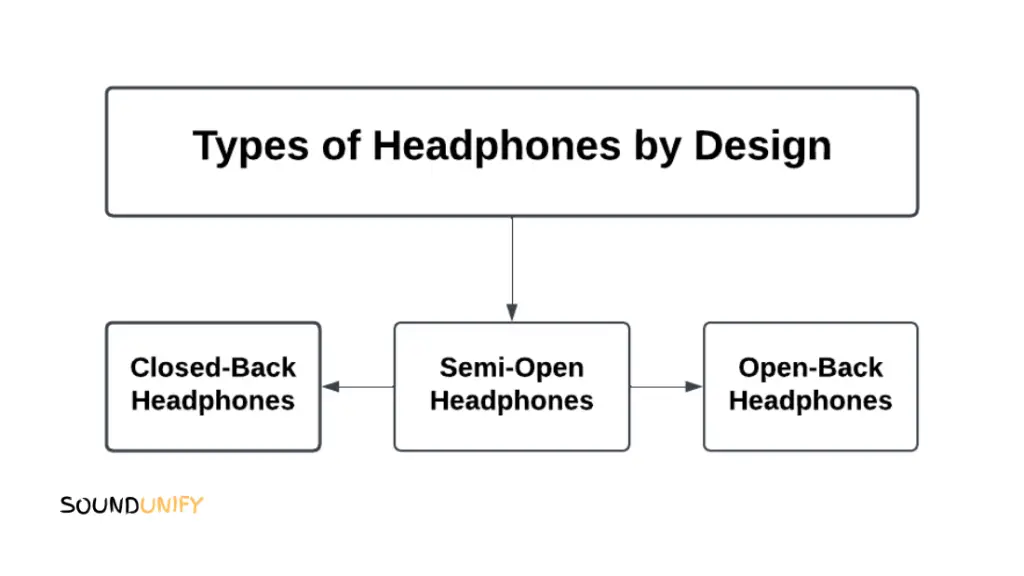
Headphones usually have a variety of types with different features and benefits. Here are some examples that are based on the design of the headphone.
1. Closed-Back Headphones
Closed-back headphones provide rich sound quality and a tight seal around your ears, which blocks out external noise and distractions. The back of its earcups that faces outwards are closed to airflow. So, they block outer sound from entering your eardrum and give you an airtight feel.
They are the perfect pick for music lovers and ideal for working out or staying on top of your essential tasks without interruption. Closed-back models are the best option if you’re looking for headphones that will give you an immersive experience.
Advantages
- It can provide a better seal around your ears, resulting in better sound quality.
- Help block out external noise, making them ideal for noisy environments.
- It can be less likely to cause listener fatigue.
2. Semi-Open Headphones
Semi-open headphones are a mixture of closed-back and open-back headphones. It can reduce some ambient sound but doesn’t block the crowd.
A chamber in a semi-open headphone can partially block sound while allowing some sound to pass through via openings or vents. It works just like you lower the volume of the TV.
Advantages
- Provide a more natural sound than closed headphones.
- Don’t block out all external noise, so you can still be aware of your surroundings.
- Don’t make your ears sweat as much.
3. Open-Back Headphones
Open-back headphones are the type of headphones that let a lot of good escape. That means the back of these headphones’ earcups is open to airflow.
The driver’s sound can flee into your ear and your immediate area. So, you wouldn’t feel ear fatigue though you use it for a more extended period as the air flows in both sides of the earcups.
Advantages
- Provide a natural and spacious soundscape.
- Don’t create as much of a “sealed off” feeling.
- Typically have a more neutral sound signature.
Types of Headphones by Connection
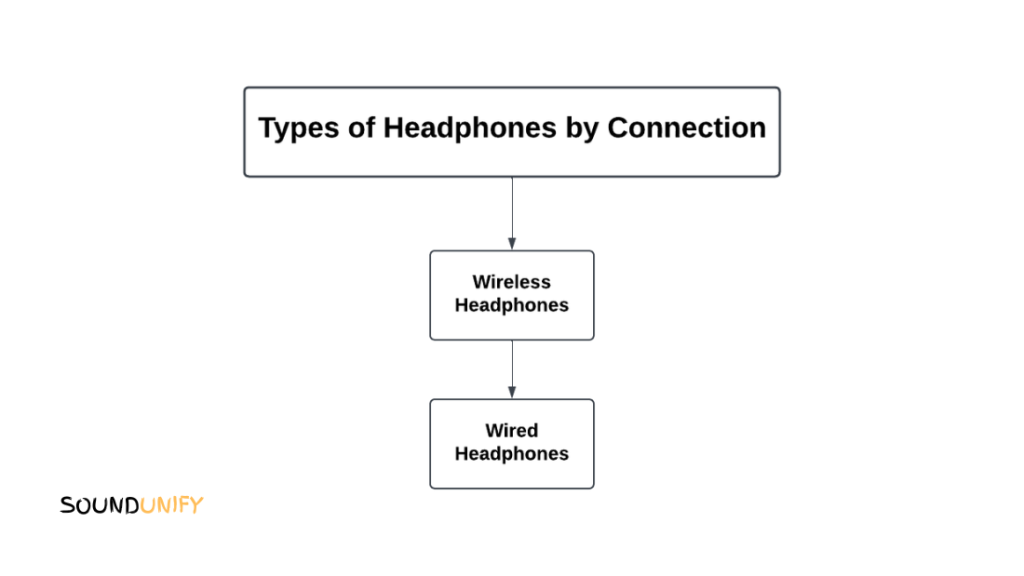
To help you out, we’ve outlined the different types of headphones by connection below. There are two types of headphones- wired and wireless- and each has its own pros and cons. Wired headphones use a wire to connect the audio source and headphones, while wireless headphones don’t have a wire connecting them.
1. Wireless Headphones
Wireless headphones are the perfect accessory for anyone who wants to stay connected while on the go. From earbuds that are discreet and easy to use to in-ear headphones that offer an extra bass boost or over-ear headphones that let you stay aware of your surroundings, there’s a type of wireless headphone for everyone.
It uses Bluetooth technology that sends a digital signal to the headphone of the music. Inside the headphones, the Digital-to-Analogue converter takes the digital signals and converts them.
However, not all wireless headphones are created equal. Earbud-style headphones are the most popular because they’re discrete and portable.
However, in-ear and over-ear types of headphones have their advantages, and in-ears often provide better sound quality than earbuds, while over-ears can help keep you insulated from noise while on long walks or runs.
Advantages
- You don’t have to worry about tangled cords.
- Very easy to carry around and store.
- Generally, have better sound quality than wired headphones.
2. Wired Headphones
Wired headphones use Analogue signals to provide sound. Analog signals can handle more data at a time than Digital signals. As a result, less processing will be required for your audio to reach you. So you can get full resolution and clear sound.
They offer an excellent level of sound clarity and bass. Those are perfect for listening to music or watching videos and provide superior sound quality over wireless headphones in terms of stability and audio fidelity.
Advantages
- Do not require batteries and can be used indefinitely.
- Not susceptible to interference from other electronic devices.
- You can use it with any device with a 3.5mm audio jack.
Special Types of Headphones
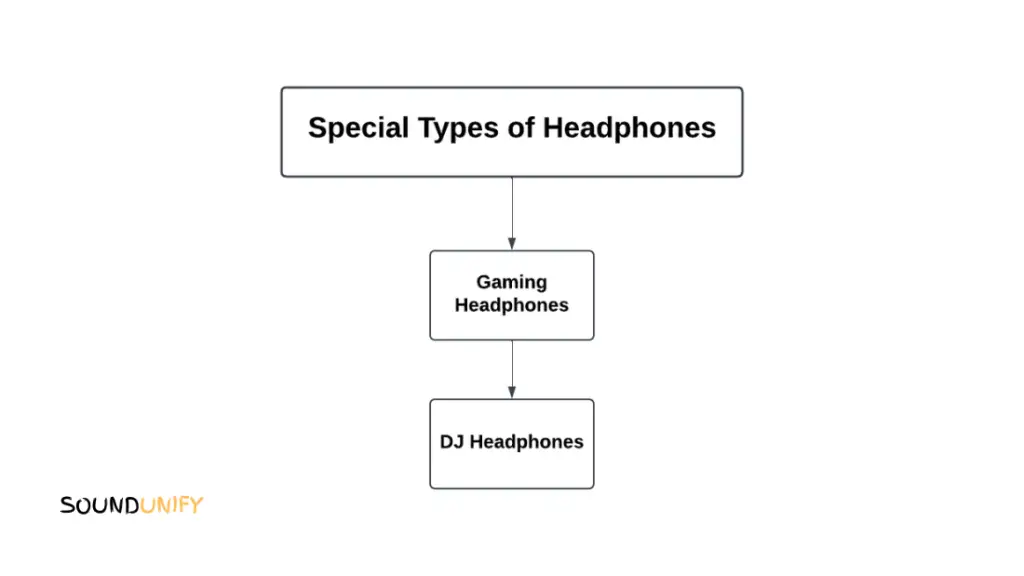
Some particular headphones require upgraded technology, noise-canceling, and all other facilities. Gaming and DJ headphones are those types.
1. Gaming Headphones
It is mainly used by ‘gamers’ who play video games regularly. It provides immersive and good directional audio crucial for enjoying the game. Gaming headphones come with a mic that lets you take calls while gaming. They also come with eye-catching designs and lighting to attract the user who is watching the gamer.
Advantages
- Help block out external noise so you can focus on the game.
- Enhance the gaming experience with surround sound.
- More comfortable to wear, stylish, and look cool.
2. DJ Headphones
Those are specially designed for DJs and other music professionals who need superior sound quality to mix or master tracks effectively. These headphones give excellent sound reproduction and isolation from outside noise. They also have a good bass response and are designed to last long hours of continuous use.
Advantages
- Allow you to hear the music clearly and without distractions.
- Help you focus on your mixing and make sure everything sounds correct.
- Durable and can withstand a lot of wear and tear.
What Are the Parts of Headphones?

The headphones have 5 main parts. Each part is essential for making the headphones comfortable and providing a good seal against outside noise.
1. Headphone speakers
The speaker is part of the headphone that emits sound. Among many qualities, higher-quality speakers provide better and crystal-clear sound to the user. Many have noise-canceling and ambient sound technology according to the user’s needs.
2. The ear cups
The ear cups are part of the headphones that go over your ears. It’s a cushioned pad that covers the speaker and gives a soft touch to the ear. Generally, it is made of synthetic leather, genuine leather, velour, memory foam, etc. It makes wearing headphones comfortable and helps grip the head to prevent slipping.
3. Headband
The headband is the part that goes over your head. It is usually adjustable so that it can fit different head sizes. Generally, it is made of metal or plastic and is covered with padding or another material to make it more comfortable to wear.
4. Cable
The cable of the headphone is the part that connects the headphone to the audio source. It is typically made of copper or other metal and is shielded to protect against interference.
5. Jack
The headphone jack is a 3.5mm audio input/output port that connects headphones or earbuds to a device, such as a smartphone, tablet, or laptop. The jack is typically located on the side or bottom of the device.
How Do Headphones Work?
When you put on a pair of headphones, what you hear is transmitted through small speakers inside your ears directly into your brain stem, where it’s processed.
That means if you’re listening to music on headphones while working out, the sound will be transmitted directly to your brain without filtering through other noises.
That is why it’s important to choose headphones specifically designed for an activity like this – if you’re using someone else’s regular earbuds, they won’t provide a good enough listening experience.
Pros and Cons of Headphones
There are various types of headphones, each with its benefits and drawbacks. Here are the four types of headphones and the purposes for which they are typically used:
1. Earbud headphones
These headphones are inserted into the ear canal and are used for listening to music or audio on the go. They are small, lightweight, and portable, which makes them perfect for on-the-go listening. They have a limited noise-canceling ability and usually do not provide high-quality sound.
2. Over-ear headphones
These headphones are worn on top of the head and provide a more immersive sound experience. They are perfect for people who want to listen to audio in a quiet environment. They are also more expensive than earbud headphones and may not be as portable.
3. In-ear headphones
These headphones are inserted directly into the ear canal and provide a sound quality that is on par with over-ear headphones. They are perfect for people who want to listen to audio in a noisy environment or are uncomfortable wearing earbuds.
4. Wireless headphones
Wireless headphones use an electromagnetic connection between the headphone and the device you’re using to play music, eliminating the need for a cord. They are portable, easy to use, and have excellent sound quality, but they can be less stable than wired headphones.
What Do People Use Headphones For?
There are many reasons people might want to use headphones when working. For example, if you’re in a noisy environment and want to concentrate on your work without distractions, wearing headphones can help you do that. Here are some more examples of where people wear headphones.
1. Work
Working in an office can be a frustrating experience at times. With the constant noise of colleagues talking, typing on their keyboards, or clicking laptops, it’s hard to concentrate on what you’re supposed to be doing.
That’s where headphones come in handy. They allow you to block out sound from outside sources and tune into your music listening to your favorite albums or songs without disturbing others.
If audio quality is essential to you- over-the-ear headphones provide superior sound quality and isolation compared with earbuds and in-ear headphones.
So, headphones are valuable if you’re looking for noise cancellation during phone calls or want the best possible audio quality when listening online!
2. Exercise
Doing exercise is sometimes very boring. You go through the motions, and nothing exciting happens. But with a good set of headphones, you can change that.
Headphones allow you to tune out all the other noises around you, including the sound of your breathing, and focus on what you’re doing. This can help increase your workout intensity, endurance, and even motivation.
3. Studying
When you are trying to concentrate on your study, there are a lot of things that can distract you. Some people might find the sound of other students typing or taking notes disruptive. While others can’t stand silence and prefer some background noise.
In either case, headphones block out all sounds around you and focus solely on your reading or studying.
4. Gaming
Gaming is all about immersing oneself in the virtual world. You can do that with fabulous headphones and get lost in your games for hours. There are different gaming headphones designed for different types of audio lovers.
There are bass-heavy headphones perfect for game lovers who want to feel the rumble of the beats. So they don’t have to hear everyone around them screaming in their ears simultaneously.
Most gaming headphones include microphone technology to skype, record video, or make calls without taking them off your head. So, grab a set of headphones for quality sound while playing your favorite game.
5. Talking on the Phone
There are a few reasons why people wear headphones to talk on the phone. Headphones can help to cancel out background noise, making it easier to hear the person on the other end of the line.
They can also be more comfortable to wear for long periods than holding a phone up to your ear. And for some people, headphones offer a more private, intimate experience when talking on the phone.
6. Waiting for an Appointment
Some people wear headphones while waiting for an appointment to pass the time by listening to music, podcasts, or other audio content. Additionally, wearing headphones can help to create a sense of privacy and personal space in a public setting.
FAQ
Q. What are the differences between wireless and wired headphones?
The main difference between wireless and wired headphones is that wireless headphones use Bluetooth technology to connect to your device, while wired headphones use a standard 3.5mm audio jack.
Wired headphones have better sound quality because they have higher audio quality than wireless ones. Wireless headphones are more convenient but require batteries and can be more expensive. Wired headphones are less expensive and don’t require batteries, but they can be less convenient.
Q. Which is better: earbuds or over-ear headphones?
If you need something that eliminates noise and gives you the best sound quality, over-ear headphones are the better option. However, if you want something more convenient and easier to carry around, earbuds might be a better choice.
Q. Is there a difference between active and passive noise-canceling headphones?
Yes, there is a difference between active and passive noise-canceling headphones. Active noise-canceling headphones use electronics to cancel out low-frequency noise, while passive noise-canceling headphones rely on sound-isolating ear cups to block noise.
The Bottom Line
Headphones are an essential part of any music lover’s arsenal. From noise-canceling earbuds to in-ear headphones to over-ear headphones, there is a type of headphones for everyone.
Some headphones are earpieces worn on the ears, while others are over-ear headphones that sit on top of the head.
They vary in how they work; some have microphone jacks so you can make cell phone calls with them, while others play sound waves through speakers inside the earbuds.
One important factor to consider when selecting headphones is what type of audio quality you want: bass-heavy for gaming or listening to songs on your smartphone’s audio jack with high-quality sound reproduction.
Or would you use noise cancellation technology so no one outside your immediate vicinity can hear what you’re listening to? There’s something for everyone.
James Dimento is a Chief-in-Editor of SoundUnify. He is a headphone enthusiast and creative writer passionate about audio technology. He has three years of experience writing about headphones and sound quality and is responsible for creating reviews and taking care of all administration.
